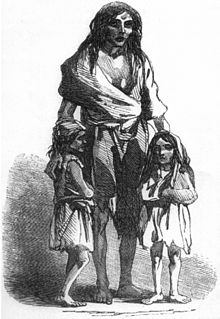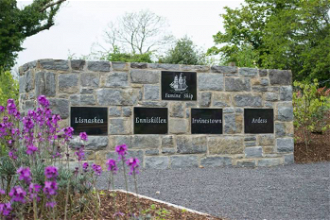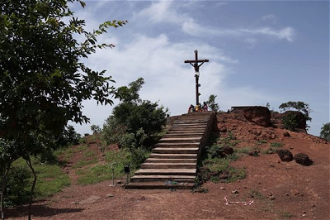Ireland: Bishop MacDaid reflects on Irish Saints and Great Famine

Bridget O'Donnell & her children 1849
On Saturday 20 August, Bishop Liam MacDaid, Bishop of Clogher, delivered reflections on Irish Saints and on the Great Famine. Bishop MacDaid's introductory remarks were delivered at the Mass of the Irish Saints celebrated at the conclusion of the Clogher Annual Diocesan Day Pilgrimage to Saint Patrick's Purgatory, Lough Derg, Co Donegal. More than 400 people took part in the Clogher day pilgrimage this year. His reflection on the Great Famine and its consequences for our people was delivered at the blessing and opening of the Famine Memorial Garden in Irvinestown, Co Fermanagh (parish of Devenish), where Bishop MacDaid was principal celebrant of the Vigil Mass at the Sacred Heart church following the blessing and opening of the garden.
Please see below both texts:
Introductory remarks at Mass of the Saints of Ireland, Saint Patrick's Basilica, Lough Derg
A Phobal Dé,
Fáilte romhaibh go leír idir muintir na háite agus sibh eile atá ar oilithreacht agus leathlá caite agaibh ar an oileán naofa seo chun caint tamall le bhur slánaitheoir Íosa Críost.
I decided that for our Mass this evening we would use the Mass of the Saints of Ireland. There is a reason for that because we are joining in spirit with another local group. Let me explain.
This part of our country has always been associated with saints since the time of Saint Patrick. Just a short distance from here is the parish of Devenish or
Irvinestown. Not so many years ago Canon Michael McGourty, a native of Belcoo was appointed Parish Priest there. He is a man of unusual interests and talents. In 2007 another man of unusual talents from Lithuania called Jonas Raiskas came to live in the area. He is a sculptor and a talented woodcarver. They joined forces and the result of their joint artistry is a little masterpiece called the Garden of Celtic Saints which is situated beside the Church in Irvinestown. If you find yourself within reach you should not pass without making a visit. It is quite a spectacle. I don't want to detain you by going into much detail. I would prefer you to see it yourself and to enjoy the artistry on which your eyes will feast.
This garden was the work of four years from 2007-2011. Never people to rest on their laurels Canon Michael and Jonas have been back at work again this time on a Parish Famine Memorial which will be a permanent memorial of a tragic time in our country's history. Most historians agree that it has left a permanent mark on the psyche of our people.
In this memorial there are four houses representing different stages of the famine tragedy. These express the breaking of the news of what was happening, a reflection on the Famine Kitchen, a reflection on the Workhouse (the only place of relief) and finally emigration, the final hope, on what were called the 'coffin ships'.
When we finish our One Day Retreat here for the people of our diocese I am due to travel to Irvinestown to bless and officially open this Parish Famine Memorial before celebrating the Vigil Mass with the people of the parish. I thought you might like to join them in spirit. That is why I have offered you these few words of explanation before we celebrate the Mass of the Irish Saints.
The Epilogue of the Service for blessing the memorial states "The description of the Famine with its death and despair was appalling. We might be tempted to think it could not have happened today. Unfortunately the truth is it could and does. This Famine Memorial may serve to help us to be more aware of the terrible conditions in which some of our brothers and sisters live and to do what we can to help avoid such disasters."
Reflection on The Great Famine and its consequences for our people
My dear friends,
It would not be possible in the time available to us to attempt to cover an adequate history of the Irish Famine in the 1840's and include some background information on causes and consequences. To give some idea of the harsh reality of the time we could attempt a summary of the consequences and even that is minimal. Bear in mind that I am not an historian.
The more reputable historians I'm told assure us that this was primarily a disaster like a flood or an earthquake. The blight was natural and no one can be held responsible for that. Conditions in Ireland which had placed thousands upon thousands of people in complete dependence on the potato are another matter. Yet the historian cannot label any class or individuals as the villains of the piece. The Irish Landlords held the ultimate responsibility but on the whole they were as much involved in disaster as their tenantry. The ministers of the crown who had to accept responsibility once the disaster occurred were callous, self-righteous and parsimonious. Yet these are the very qualities Charles Dickens, for instance, found so distasteful in men of their class and they were exhibited as much to English as to the Irish poor.
The potato blight had destroyed the ramshackle economy which had grown up during the French Wars. A staggering problem of unemployment was liquidated in the most terrible sense of that word. In 1851 the population was 6 ½ million, 2 million less than the estimated population of 1845. Something like a million had succeeded in getting away and another million had perished. Yet if we turn to the agricultural statistics we find that despite the loss, Irish production had increased rather than diminished. The area under cultivation had increased by over a million acres. The loss of population was paralleled by a decline in the number of holdings. Holdings of not more than five acres had fallen from 45% of the total to just over 15%. Holdings of over 30 acres were now 26% instead of 7%.
The pattern of modern Irish agriculture was beginning to emerge from the ruin caused by the potato blight, - a family farm engaged in mixed tillage and livestock production, with the stock rather than the grain increasingly providing cash income. The halt to subdivision of necessity brought fundamental social changes in Ireland as well. Gone were the days of early marriage and a countryside thronged with young people and children. For many the price of holding together the family farm was to remain unmarried. For many others there could be no staying in Ireland, and their energies went to the building of the United States or other new lands across the sea. Against the economic improvement must be set a worsening of political conditions. The resentment in Ireland against English handling of the famine crisis was deep and slow to heal. Worse still was the bitter history between landlord and tenant which boiled over into a great agrarian conflict when falling farm prices caught the farmer in the late seventies. Change in such conditions was necessarily slow, and even today it might be argued that we still have much to do to repair the damage that the Irish economy suffered in the early 19th century and to heal the scars that the famine left on our society. That's how far reaching it was and how serious the consequences were for our country and its people.
Bishop Liam S MacDaid
Bishop of Clogher




















